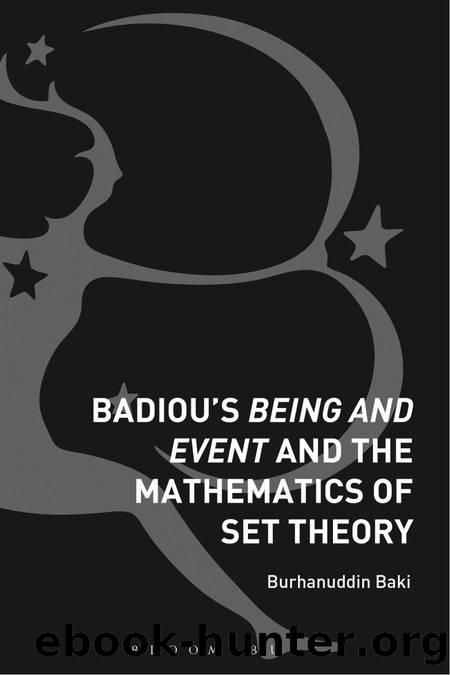Badiou's Being and Event and the Mathematics of Set Theory by Baki Burhanuddin;

Author:Baki, Burhanuddin;
Language: eng
Format: epub
ISBN: 9781472578716
Publisher: Bloomsbury UK
Published: 2019-11-22T16:00:00+00:00
An ordinal is the set of the ordinals preceding it
Now there is another property of the ordinals that we have postponed mentioning. Except for 0, every ordinal number is defined as equivalent to the set of ordinals preceding it. In other words, the ordinals are exactly equal to the initial segments we mentioned. The ordinal 6, for example, is the set of ordinals from 0 to 5:
6 = {0,1,2,3,4,5}.
So, in general, every natural number n, when conceived as an ordinal, is precisely the set of all natural numbers preceding n. So n = {0,1,2, …, n} for every n ∈ ℕ, and likewise for the infinite ordinals λ = {x: x < λ} for every ordinal λ except for 0. Thus, every ordinal is identical to the sequence of ordinals preceding it. Since every order type can be matched to an initial segment of the ordinals and every initial segment is, in fact, an ordinal itself, we have therefore provided a match between the order types and the ordinals.
Now the principle behind set theory is that every mathematical object is a set. As given previously, an ordinal is simply the set of all ordinals preceding it:
1 = {0}
2 = {0,1}
3 = {0,1,2}
4 = {0,1,2,3}
⋮
ω = {0,1,2,3, …}
ω + 1 = {0,1,2,3, … ω}
⋮
Since every ordinal refers back to all the ordinals before it, every ordinal ultimately comes back to the first ordinal, namely 0. Hence, each ordinal is built from zero. The set-theoretic construction is completed with the decision to equate the ordinal 0 with the empty set ∅ itself. This makes sense since zero and the empty set are simply different proper names for the void itself.
0 = ∅
1 = {∅}
2 = {∅, {∅}}
3 = {∅, {∅}, {∅, {∅}}}
4 = {∅, {∅}, {∅, {∅}}, {∅, {∅}, {∅, {∅}}}}
⋮
ω = {∅, {∅}, {∅, {∅}}, {∅, {∅}, {∅, {∅}}}, … }
ω + 1 = {∅, {∅}, {∅, {∅}}, {∅, {∅}, {∅, {∅}}}, …, {∅, {∅}, {∅, {∅}}, {∅, {∅}, {∅, {∅}}}, … }}
⋮
Moreover, every ordinal is a pure set, since there is nothing inside them other than the empty set and the onion layers of brackets.
The link between ordinals and well-foundedness implies what is called the Principle of Unique ∈-Minimality for Ordinals. Badiou expounds this principle in the first appendix to Being and Event. ‘If there exists an ordinal which possesses a given property, there exists a smallest ordinal which has that property: it possesses the property, but the smaller ordinals, those that belong to it, do not’ (BE, 519). Since every ordinal is well-founded when ordered according to belonging, every set of ordinals has a first element, the smallest ordinal of that set. This means that any collection of ordinals defined under some predicate has a unique first element.
Download
This site does not store any files on its server. We only index and link to content provided by other sites. Please contact the content providers to delete copyright contents if any and email us, we'll remove relevant links or contents immediately.
| Anthropology | Archaeology |
| Philosophy | Politics & Government |
| Social Sciences | Sociology |
| Women's Studies |
Lateral Thinking by Edward de Bono(894)
The Little Blue Reasoning Book: 50 Powerful Principles for Clear and Effective Thinking by Brandon Royal(756)
A Primer on Legal Reasoning by Michael Evan Gold(701)
A Rulebook for Arguments by Weston Anthony;(680)
Dictionary of Untranslatables: A Philosophical Lexicon (Translation/Transnation)(573)
Every Word Is a Bird We Teach to Sing by Daniel Tammet(504)
Poor Richard's Almanack by Benjamin Franklin(489)
So You Think You Can Think by Christopher W. DiCarlo(472)
From Poverty to Power by James Allen(464)
The Art of Logical Thinking by William Atkinson(461)
Logics and Falsifications by Andreas Kapsner(458)
Irony and Sarcasm by Roger Kreuz;(451)
The Art Of Thinking In Systems: Improve Your Logic, Think More Critically, And Use Proven Systems To Solve Your Problems - Strategic Planning For Everyday Life by Steven Schuster(448)
Game of Logic by Lewis Carroll(434)
Logic Made Easy by Deborah J. Bennett(427)
How to Win Every Argument: The Use and Abuse of Logic (2006) by Madsen Pirie(425)
The Ingenious Language by Andrea Marcolongo(415)
The Practice of Argumentation (Critical Reasoning and Argumentation) by David Zarefsky(412)
The Moscow Puzzles: 359 Mathematical Recreations by Boris A. Kordemsky(410)
